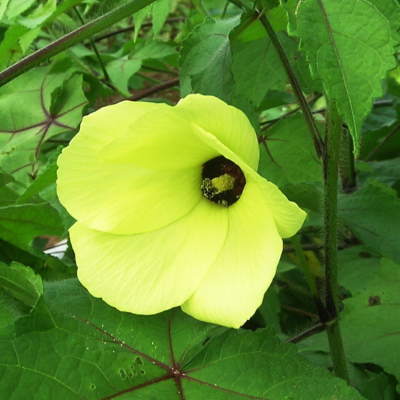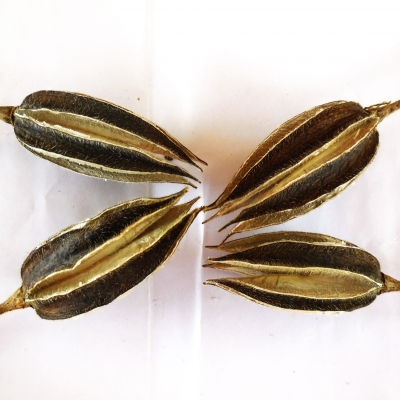Abelmoschus moschatus (Linn.) Medicus
Synonyms : Hibiscus abelmoshus Linn
Family : Malvaceae
Group : Aphrodisiac/spermatogenesis
Parts Used : Fruit , Seed , Flower , seed oil
Vernacular Names :-
| English | : | Ambrette plant, Musk, Muskmallow |
| Malayalam | : | Kasthuri venda |
| Hindi | : | Guj |
| Sanskrit | : | Latakasturika |
| Kannada | : | Kasturi bende |
| Tamil | : | Varttilaikasturi |
| Telungu | : | Kasturi benda |
Distribution and Habitat:
The plant is a native of India, it grows in the tropical subtropical and hilly regions of the country; particularly in the states of Maharashtra, Gujarat, Madhya Pradesh, Tamil Nadu & Kerala.
Botany: Erect annual herb of 60-180 cm in height.
- Leaves: Simple polymorphous, palmately 3-7 lobed; serrate or irregularly toothed, hairy on both surfaces.
- Flowers: Large and bright yellow with purple centre.
- Fruits: Fulvous, hairy & capsular.
- Seeds: Sub-reniform, black or greyish - brown & musk-scented
Chemical constituents:
- Seed oil contains the phospholipids: 2 - cephalin, phosphatidylserine and its plasmalogen and phosphatidyl choline plasmalogen.
- Absolute contains farnesol and ambrettolic acid lactone.
- Petals contain β -sitosterol, flavonoid myrcetin & its glucoside.
- Flowers contain anthocyanins.
Uses: Every part is used in one or the other way.
- Seeds are effective aphrodisiac, antispasmodic, & used in tonics. They check vomiting and are useful in treating intestinal disorders, urinary discharge, nervous disorders, hysteria, skin diseases etc.
- Flower infusion is a contraceptive. It is used for making ‘zarda’ a flavoured tobacco in India
- Ambrette oil of commerce is extracted from the seeds and is used in perfumery, flavouring, cosmetic and agarbathi industries.
- The aromatic concrete and absolute, extracted from seeds are used as base material for preparing high grade perfumes, scents and cosmetics.
Agrotechnology
Soil and climate: Ambrette is a hardy plant, can be grown under tropical and subtropical conditions. Both as a rainfed crop and as an irrigated crop. Well-drained loamy and sandy loam soils. Loamy soils with neutral pH and plenty of organic matter are ideal for its cultivation.
Propagation: Through seeds. The optimum time of sowing is June-July with pre-monsoon showers. Ridges and furrows are formed giving a spacing of 60 - 100 cm. Seed rate is 2-3 kg/ha. Presoaking for 24 hours is done. It takes 6-7 days for proper germination.
Manuring: Well-decomposed FYM or compost is incorporated into the soil at 10-15 t/ha. Recommended dose of fertiliser is 120:40:40 kg N, P2O5, K2O/ha with Phosphorus as basal application. N and K are applied in 3 equal doses at planting, 2 and 4 months after planting.
Irrigation: Soon after sowing, twice a week during the initial period and once a week thereafter.
Plant protection: The plants suffer from pests like spider mites, fruit bores and leaf-eating caterpillars. Diseases like powdery mildew and wilt are also observed. Spider mites and powdery mildew are controlled by spraying 30 g wettable sulphur in 10 litres of water. Pod borers can be controlled by spraying 20 ml oxydemeton methyl in 10 litres of water.
Harvesting: The crop is having 170-180 days duration. Flowering starts about 75 days after sowing. Flowering and fruit setting extends from October to April. The flowers set into fruits in 3-4 days and the pods take nearly a month to mature. Pods have to be plucked as soon as they attain black color; otherwise, they split and seeds scatter. The pods are further dried and threshed to separate seeds. The seed yield is 1-1.5 t /ha. The seeds can be stored without loss of fragrance in a cool dry place.
Processing: The oil is extracted from seed by steam distillation followed by solvent extraction. The concrete of solvent extraction is further extracted with alcohol to get the absolute, that is, the alcohol-soluble volatile concentrate.



